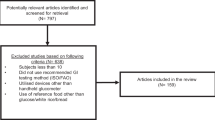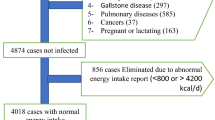Abstract
The concept of glycaemic index (GI) was developed 25 years ago by Jenkins and co-workers in 1981 and first studied to help diabetic patients with blood glucose control. In 1997 two epidemiological studies were published showing that high GI food consumption is associated with an increased risk of type 2 diabetes. At the same time the concept of the glycaemic load (GL) was introduced, based on GI and total carbohydrate intake. Since then, many studies have been conducted to investigate the role of dietary GI and GL in the prevention and management of type 2 diabetes, cardiovascular disease, obesity and other chronic diseases such as cancer. The current review will focus on the epidemiological evidence obtained so far. In addition, several key methodological issues will be addressed, such as the dietary assessment method used, the application of the international GI and GL table, and the correlated dietary patterns.
This is a preview of subscription content, access via your institution
Access options
Subscribe to this journal
Receive 12 print issues and online access
$259.00 per year
only $21.58 per issue
Buy this article
- Purchase on Springer Link
- Instant access to full article PDF
Prices may be subject to local taxes which are calculated during checkout

Similar content being viewed by others
References
FAO/WHO. Cabohydrates in Human Nutrition. A summary of the Joint FAO/WHO Expert Consultation. Rome 14–18 April 1997.
Wolever TM, Jenkins DJ, Jenkins AL, Josse RG . The glycemic index: methodology and clinical implications. Am J Clin Nutr 1991; 54: 846–854.
Vaughan L . Professional consensus statement – Suggested good practice for Dietitians involved in the dietetic management of adults, with type 1 diabetes, treated with insulin analogues. The Diabetes Management and Education group of the British Dietetic Association; March, 2005.
Connor H, Annan F, Bunn E, Frost G, McGough N, Sarwar T et al. The implementation of nutritional advice for people with diabetes. Diabet Med 2003; 20: 786–807.
Salmeron J, Manson JE, Stampfer MJ, Colditz GA, Wing AL, Willett WC . Dietary fiber, glycemic load, and risk of non-insulin-dependent diabetes mellitus in women. JAMA 1997; 277: 472–477.
Salmeron J, Ascherio A, Rimm EB, Colditz GA, Spiegelman D, Jenkins DJ et al. Dietary fiber, glycemic load, and risk of NIDDM in men. Diabetes Care 1997; 20: 545–550.
Fontvieille AM, Rizkalla SW, Penfornis A, Acosta M, Bornet FR, Slama G . The use of low glycaemic index foods improves metabolic control of diabetic patients over five weeks. Diabet Med 1992; 9: 444–450.
Brand JC, Colagiuri S, Crossman S, Allen A, Roberts DC, Truswell AS . Low-glycemic index foods improve long-term glycemic control in NIDDM. Diabetes Care 1991; 14: 95–101.
Brand-Miller J, Hayne S, Petocz P, Colagiuri S . Low-glycemic index diets in the management of diabetes: a meta-analysis of randomized controlled trials. Diabetes Care 2003; 26: 2261–2267.
Opperman AM, Venter CS, Oosthuizen W, Thompson RL, Vorster HH . Meta-analysis of the health effects of using the glycaemic index in meal-planning. Br J Nutr 2004; 92: 367–381.
Sheard NF, Clark NG, Brand-Miller JC, Franz MJ, Pi-Sunyer FX, Mayer-Davis E et al. Dietary carbohydrate (amount and type) in the prevention and management of diabetes: a statement by the american diabetes association. Diabetes Care 2004; 27: 2266–2271.
Franz MJ, Bantle JP, Beebe CA, Brunzell JD, Chiasson JL, Garg A et al. Nutrition principles and recommendations in diabetes. Diabetes Care. Jan 2004; 27 Suppl 1: S36–S46.
Wolever TM . Food glycaemic index or meal glycaemic response? Hum Nutr Appl Nutr 1987; 41: 434–435.
Wolever TM, Csima A, Jenkins DJ, Wong GS, Josse RG . The glycemic index: variation between subjects and predictive difference. J Am Coll Nutr 1989; 8: 235–247.
Byrnes SE, Miller JC, Denyer GS . Amylopectin starch promotes the development of insulin resistance in rats. J Nutr 1995; 125: 1430–1437.
Pawlak DB, Kushner JA, Ludwig DS . Effects of dietary glycaemic index on adiposity, glucose homoeostasis, and plasma lipids in animals. Lancet 2004; 364: 778–785.
Wolever TM, Jenkins DJ, Ocana AM, Rao VA, Collier GR . Second-meal effect: low-glycemic-index foods eaten at dinner improve subsequent breakfast glycemic response. Am J Clin Nutr 1988; 48: 1041–1047.
Wolever TM, Mehling C . Long-term effect of varying the source or amount of dietary carbohydrate on postprandial plasma glucose, insulin, triacylglycerol, and free fatty acid concentrations in subjects with impaired glucose tolerance. Am J Clin Nutr 2003; 77: 612–621.
Schulze MB, Liu S, Rimm EB, Manson JE, Willett WC, Hu FB . Glycemic index, glycemic load, and dietary fiber intake and incidence of type 2 diabetes in younger and middle-aged women. Am J Clin Nutr 2004; 80: 348–356.
Hodge AM, English DR, O’Dea K, Giles GG . Glycemic index and dietary fiber and the risk of type 2 diabetes. Diabetes Care 2004; 27: 2701–2706.
Stevens J, Ahn K, Juhaeri, Houston D, Steffan L, Couper D . Dietary fiber intake and glycemic index and incidence of diabetes in African-American and white adults: the ARIC study. Diabetes Care 2002; 25: 1715–1721.
Meyer KA, Kushi LH, Jacobs Jr DR, Slavin J, Sellers TA, Folsom AR . Carbohydrates, dietary fiber, and incident type 2 diabetes in older women. Am J Clin Nutr 2000; 71: 921–930.
Schulz M, Liese AD, Fang F, Gilliard TS, Karter AJ . Is the Association Between Dietary Glycemic Index and Type 2 Diabetes Modified by Waist Circumference? Diabetes Care 2006; 29: 1102–1104.
van Dam RM, Visscher AW, Feskens EJ, Verhoef P, Kromhout D . Dietary glycemic index in relation to metabolic risk factors and incidence of coronary heart disease: the Zutphen Elderly Study. Eur J Clin Nutr 2000; 54: 726–731.
McKeown NM, Meigs JB, Liu S, Saltzman E, Wilson PW, Jacques PF . Carbohydrate nutrition, insulin resistance, and the prevalence of the metabolic syndrome in the Framingham Offspring Cohort. Diabetes Care 2004; 27: 538–546.
Lau C, Faerch K, Glumer C, Tetens I, Pedersen O, Carstensen B et al. Dietary glycemic index, glycemic load, fiber, simple sugars, and insulin resistance: the Inter99 study. Diabetes Care 2005; 28: 1397–1403.
Liese AD, Schulz M, Fang F, Wolever TM, D’Agostino Jr RB, Sparks KC et al. Dietary glycemic index and glycemic load, carbohydrate and fiber intake, and measures of insulin sensitivity, secretion, and adiposity in the Insulin Resistance Atherosclerosis Study. Diabetes Care 2005; 28: 2832–2838.
Feskens EJ, Bowles CH, Kromhout D . Carbohydrate intake and body mass index in relation to the risk of glucose intolerance in an elderly population. Am J Clin Nutr 1991; 54: 136–140.
Franz MJ, Bantle JP, Beebe CA, Brunzell JD, Chiasson JL, Garg A et al. Evidence-based nutrition principles and recommendations for the treatment and prevention of diabetes and related complications. Diabetes Care 2002; 25: 148–198.
Chiasson JL, Josse RG, Gomis R, Hanefeld M, Karasik A, Laakso M . Acarbose treatment and the risk of cardiovascular disease and hypertension in patients with impaired glucose tolerance: the STOP-NIDDM trial. JAMA 2003; 290: 486–494.
DECODE Study Group, on behalf of the European Diabetes Epidemiology Group. Glucose tolerance and cardiovascular mortality: comparison of fasting and 2-hour diagnostic criteria. Arch Intern Med 2001; 161 (3): 397–405.
Ludwig DS . The glycemic index: physiological mechanisms relating to obesity, diabetes, and cardiovascular disease. JAMA 2002; 287: 2414–2423.
Liu S, Manson JE, Buring JE, Stampfer MJ, Willett WC, Ridker PM . Relation between a diet with a high glycemic load and plasma concentrations of high-sensitivity C-reactive protein in middle-aged women. Am J Clin Nutr 2002; 75: 492–498.
Reaven GM . Banting lecture 1988. Role of insulin resistance in human disease. Diabetes 1988; 37: 1595–1607.
Despres JP, Lamarche B, Mauriege P, Cantin B, Dagenais GR, Moorjani S et al. Hyperinsulinemia as an independent risk factor for ischemic heart disease. N Engl J Med 1996; 334: 952–957.
Wolever TM, Bolognesi C . Prediction of glucose and insulin responses of normal subjects after consuming mixed meals varying in energy, protein, fat, carbohydrate and glycemic index. J Nutr 1996; 126: 2807–2812.
Jenkins DJ, Wolever TM, Kalmusky J, Guidici S, Giordano C, Patten R et al. Low-glycemic index diet in hyperlipidemia: use of traditional starchy foods. Am J Clin Nutr 1987; 46: 66–71.
Frost G, Leeds AA, Dore CJ, Madeiros S, Brading S, Dornhorst A et al. Glycaemic index as a determinant of serum HDL-cholesterol concentration. Lancet 1999; 353: 1045–1048.
Ford ES, Liu S . Glycemic index and serum high-density lipoprotein cholesterol concentration among us adults. Arch Intern Med 2001; 161: 572–576.
Qi L, Rimm E, Liu S, Rifai N, Hu FB . Dietary glycemic index, glycemic load, cereal fiber, and plasma adiponectin concentration in diabetic men. Diabetes Care 2005; 28: 1022–1028.
Jarvi AE, Karlstrom BE, Granfeldt YE, Bjorck IE, Asp NG, Vessby BO et al. Improved glycemic control and lipid profile and normalized fibrinolytic activity on a low-glycemic index diet in type 2 diabetic patients. Diabetes Care 1999; 22: 10–18.
Pereira MA, Swain J, Goldfine AB, Rifai N, Ludwig DS . Effects of a low-glycemic load diet on resting energy expenditure and heart disease risk factors during weight loss. JAMA 2004; 292: 2482–2490.
Liu S, Willett WC, Stampfer MJ, Hu FB, Franz M, Sampson L et al. A prospective study of dietary glycemic load, carbohydrate intake, and risk of coronary heart disease in US women. Am J Clin Nutr 2000; 71: 1455–1461.
Oh K, Hu FB, Cho E, Rexrode KM, Stampfer MJ, Manson JE et al. Carbohydrate intake, glycemic index, glycemic load, and dietary fiber in relation to risk of stroke in women. Am J Epidemiol 2005; 161: 161–169.
Tavani A, Bosetti C, Negri E, Augustin LS, Jenkins DJ, La Vecchia C et al. Carbohydrates, dietary glycaemic load and glycaemic index, and risk of acute myocardial infarction. Heart 2003; 89: 722–726.
Brand-Miller JC, Holt SH, Pawlak DB, McMillan J . Glycemic index and obesity. Am J Clin Nutr 2002; 76: 281S–285S.
Toeller M, Buyken AE, Heitkamp G, Cathelineau G, Ferriss B, Michel G . Nutrient intakes as predictors of body weight in European people with type 1 diabetes. Int J Obes Relat Metab Disord 2001; 25: 1815–1822.
Kromhout D, Bosschieter EB, de Lezenne Coulander C . Dietary fibre and 10-year mortality from coronary heart disease, cancer, and all causes. The Zutphen study. Lancet 1982; 2: 518–522.
Bloemberg BP, Kromhout D, Obermann-De Boer GL, Van Kampen-Donker M . The reproducibility of dietary intake data assessed with the cross-check dietary history method. Am J Epidemiol 1989; 130: 1047–1056.
Hertog MG, Feskens EJ, Kromhout D . Antioxidant flavonols and coronary heart disease risk. Lancet 1997; 349: 699.
Ocke MC, Bueno-de-Mesquita HB, Pols MA, Smit HA, van Staveren WA, Kromhout D . The Dutch EPIC food frequency questionnaire. II. Relative validity and reproducibility for nutrients. Int J Epidemiol 1997; 26 (Suppl 1): S49–S58.
Bingham SA, Day NE, Luben R, Ferrari P, Slimani N, Norat T et al. Dietary fibre in food and protection against colorectal cancer in the European Prospective Investigation into Cancer and Nutrition (EPIC): an observational study. Lancet 2003; 361: 1496–1501.
Foster-Powell K, Holt SH, Brand-Miller JC . International table of glycemic index and glycemic load values: 2002. Am J Clin Nutr 2002; 76: 5–56.
Henry CJ, Lightowler HJ, Strik CM, Storey M et al. Glycaemic index values for commercially available potatoes in Great Britain. Br J Nutr 2005; 94: 917–921.
Acknowledgements
This work was partly supported by the Diogenes project (Contract No. FP6-513946) from the European Union Sixth Framework Programme. We appreciate the contribution of with Dr Marit van Bakel, IARC, Lyon, and the input of Professor Thomas MS Wolever, University of Toronto, Canada, during the preparation of this manuscript.
Author information
Authors and Affiliations
Corresponding author
Rights and permissions
About this article
Cite this article
Feskens, E., Du, H. Dietary glycaemic index from an epidemiological point of view. Int J Obes 30 (Suppl 3), S66–S71 (2006). https://doi.org/10.1038/sj.ijo.0803495
Published:
Issue Date:
DOI: https://doi.org/10.1038/sj.ijo.0803495
Keywords
This article is cited by
-
Dietary glycaemic index, glycaemic load and endometrial and ovarian cancer risk: a systematic review and meta-analysis
British Journal of Cancer (2008)



